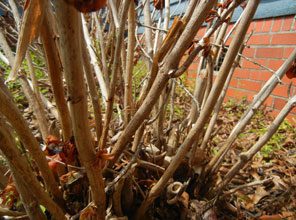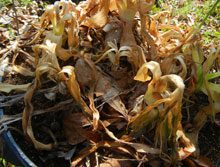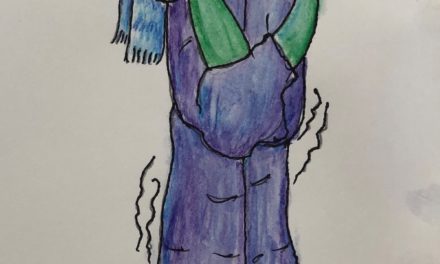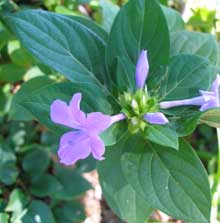 I really didn’t intend to be so right; that last gardening column I wrote for this space at the end of February, composed after weeks of warmer than usual weather and with predictions of more warm weather to come, that last column warned us all to beware assuming that winter was over.
I really didn’t intend to be so right; that last gardening column I wrote for this space at the end of February, composed after weeks of warmer than usual weather and with predictions of more warm weather to come, that last column warned us all to beware assuming that winter was over.
I reminded everyone that March often holds out one last frigid attack on the garden, and that we all would be wise to be ready to face a sudden cold snap – even a freeze – before spring finally, actually, arrived.
I think I didn’t truly believe my own advice. I blithely rejoiced in all that early spring growth of flowers and even new tender leaves in February and into early March. I began to garden as if spring had already begun, and I needed to work harder because all this new growth was happening so fast.
Then, a couple of weeks ago, it hit us. Hard freezes, deep cold, killing frosts. For weeks now I have been getting calls and emails from gardeners all over the state asking, “What do we do now?” “Can my shrubs be saved?” “What can I do about these azaleas?”
Those of us who garden within spitting distance of the ocean or the tidal creeks were pretty lucky, for the most part – at least at this far southern end of the Carolina coast. The damage seems to have been primarily some dieback on sensitive shrubs and early-flowering trees, and some garden plants which had gotten too fast a start in February’s warm weather were zapped back.
A little more inland, where my Beaufort County garden is, the damage was a little worse than  that. Especially disheartening was the huge old saucer magnolia, which had been in full bloom in February; with the premature winter warmth encouraging it, the tree had put out a full flush of green leaves – every one of which was killed back to a papery brown trash heap. Most of the other plants were under the somewhat protective cover of the tall pines, and they managed reasonably well. There was some browning of sensitive bulbs like the crinums and hymenocallis, but nothing too grotesque.
that. Especially disheartening was the huge old saucer magnolia, which had been in full bloom in February; with the premature winter warmth encouraging it, the tree had put out a full flush of green leaves – every one of which was killed back to a papery brown trash heap. Most of the other plants were under the somewhat protective cover of the tall pines, and they managed reasonably well. There was some browning of sensitive bulbs like the crinums and hymenocallis, but nothing too grotesque.
It was the midlands and upstate which seem to have really taken a hit from the March freeze. Our garden at the farm is on the southern edge of this region, and the farther north the garden, the more dramatic the freeze damage appeared.
At the farm, every one of my garden hydrangeas, the mophead blue and pink beauties of late spring, had killed every bit of their burgeoning new green growth. There will be no hydrangea blooms on those this year. Interestingly, however, the native Oakleaf Hydrangeas had delayed their own spring growth, so they were completely unaffected by the freeze. Those magnificent shrubs will bloom just fine.
The deciduous magnolias had finished blooming when the freeze came, and every leaf on every limb was killed completely back. Horrible! And the nearby pomegranate tree, which had already leafed out and begun flowering, was frozen back to bare brown twigs. Several beautiful viburnums had their new leaves scorched a bit by the cold, but otherwise they look healthy. The roses, of course, completely ignored the cold weather, and they’re growing at full speed.
The newly-sprung gladioli, the crinums, all the agapanthus, the amaryllis – these bulbs were all killed back to the ground. All, however, have started growth again, picking up where they left off. I wonder how many of them will decide to take this year off from the effort of blooming, and instead use their time in the sun to grow good leaves and build up energy for the following year.
Panicked gardener friends from all over were in touch right away, desperately hoping that they might save some of their plants after such damage, wondering whether it was better to just to start digging the worst ones up and replacing them. The most frequent questions were about pruning the freeze-damaged shrubs: When? How? Where?
Fortunately for everyone’s sake, the very best advice here is the simplest. Relax, be patient. It may take a while, but you want to know just how much killing damage has been done to your plants before you do anything drastic. Watch for new growth to replace the freeze-damaged growth. If you don’t see new growth, you can scrape off a little of the bark on a stem, and if you see a bit of green tissue beneath the bark, then it’s still alive.
It’s pretty much okay to go ahead and remove any of the limbs that you are certain have died. Pruning is a peculiar thing, and it helps to have a pretty clear idea of what you want to end up with before you start cutting.
If most of the plant has survived, and is starting to put out new growth, you may want simply to prune carefully to cut out dead wood and to improve the shape of the plant and maybe improve airflow and exposure to light.
Several friends worried about their beautiful azaleas. The freeze killed all the blooms, the plants look a mess, and they wonder if it’s worth saving them. In most cases, these azaleas were the Indica types, and they usually come through these experiences reasonably well. It just means the flowering season is interrupted and should return next year. If pruning is called for, the best time to do azaleas is just after they finish blooming, so now’s the time.
Some things – like my mophead hydrangeas, or many of the roses – benefit from an occasional severe pruning. Usually, in the case of the hydrangeas, I remove about a third of the number of the stalks – choosing the oldest ones – making sure to leave the growing tips of the remaining stalks to bloom. This year, however, all those growing tips were killed back and the plants will not be able to make blooms on these old stems.
This year, I am cutting all the hydrangeas back to the ground. This will encourage vigorous and healthy new growth, big leaves, and excellent stems for blooms next year.
I’ve also cut all those leafless rose stems back to healthy buds about eight inches or a foot above the ground. Unlike the hydrangeas, the roses will bloom on new stems growing this year, so for these I’m making them send up some strong new stems.
I should mention that my adored shrub roses, like Cramoisi Superieur, keep many leaves all year, and they will bloom in profusion on all new growth. So I prune to leave fewer and bigger stems when I want fewer bigger blooms; and more rambling branches when I want more, but smaller, blooms.
For most of the state, peach farmers and blueberry farmers report that whatever crop is harvested this year, it will be very small.
The lesson, dear Gardener, is to beware complacency, expect difficult weather, and rejoice in the gifts that come in any weather.








